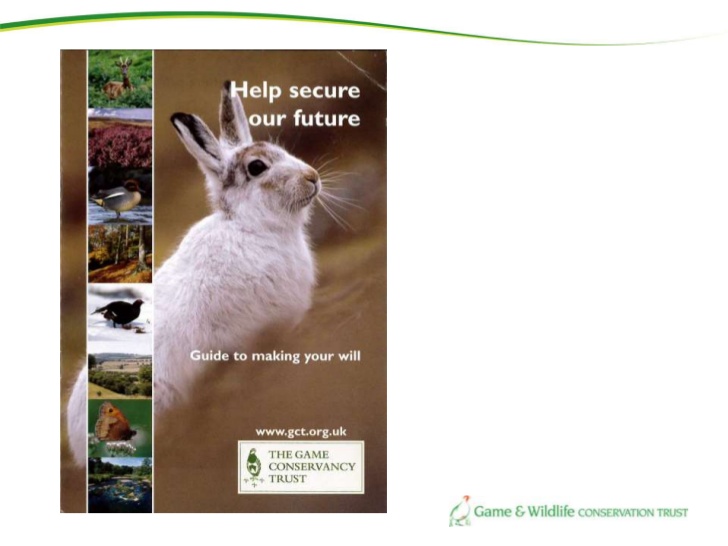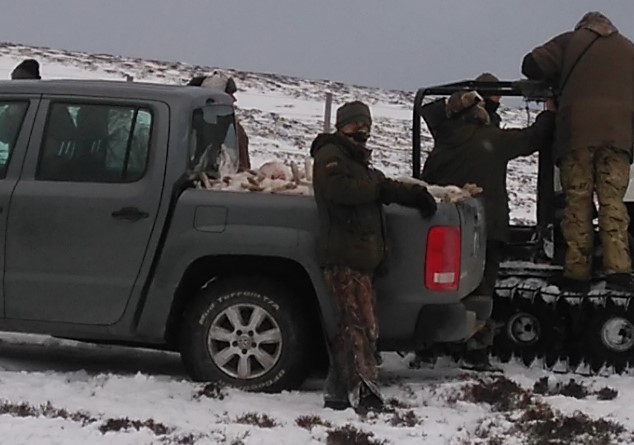 Mountain Hares rush to leave their worldly possessions to the GWCT – not!
Mountain Hares rush to leave their worldly possessions to the GWCT – not!
Adam Smith from the Game and Wildlife Conservation Trust in Scotland said that it was possible the dead hares in the photo below were “part of a sustainable harvest”. That’ll be a great relief to these Mountain Hares and they will be thrilled to have laid down their lives ‘sustainably’ for the sport of grouse shooting. It’s not known whether the GWCT have the same attitude to small wars and the murder rate in the UK, ‘They don’t really matter at all as they won’t affect the overall population level – they are a welcome part of sustainable development‘ they, obviously, didn’t say.
Mountain Hares are killed routinely as ‘pests’ in our National Parks because they can carry ticks that can transmit diseases to Red Grouse that people will pay to shoot. It’s also convenient to remove the main prey item of Golden Eagles from your grouse moor. Please make your views known on the future of our National Parks through this website on the future of our National Parks.
You could also sign this e-petition asking Scottish ministers to protect the Mountain Hare.
[registration_form]

Well done, Mark, for keeping up the pressure on this issue. It really is appalling what goes on in our countryside with the abject indifference of people who are tasked with promoting biodiversity and human well-being.
Words almost fail. What absurd little collisions they get into to maintain the savagery which they excuse as a ‘way of life’. They’ve all become hideously desensitized to the true value of nature and in a just world would be excluded from the land. And the storm-troopers with their big-boys toys -appreciate the wilderness and its life – don’t destroy it!
Mark you have made some good points of the Hares but this is getting silly. Do you have these same expectations on yourself when you eat fish or your bacon sandwiches? Or when you drive your car through clouds of insects – their lives matter too you know. I don’t think you do. Yes we need more oversight on all wild harvesting, but lets not muddle our conservation values with protectionism too much.
I guess that many people do have exactly those thoughts when they eat their fish and chips or bacon sandwiches. You may have noticed that for many years now, there has been concern about over-fishing and its impacts on fish stocks and much debate over which species from which fisheries can be consumed sustainably. Equally you might have seen – here and elsewhere – that many people are concerned about the impacts of farming on the countryside and seek to find ways of reducing this impact and making food production more sustainable.
A very limited definition of a sustainable harvest would be one in which the level of harvesting is matched by the rate of replenishment of the population being harvested but – at the very least when we are talking about recreational activities in a national park – I would suggest that to be considered sustainable the harvest would also need to leave the ecosystem as a whole functioning effectively. I would love to know by what measure GWCT considers a mountain hare cull to be sustainable and what data they have to show that the removal of truckloads of hares from the hills might be sustainable. If the cull reduces the density of mountain hares below the level required to support a golden eagle territory then I don’t see how it can be referred to as a sustainable harvest.
Since when has harvesting involved killing and leaving to rot Tom? I’ve seen it over and over again in the Peak District.
The equivalence you are looking for would be Mark walking into a shop for a bacon sandwich and then throwing all the cheese ones on the floor because he doesn’t like them.
‘Whataboutery’ is never a great defence of anything. It implies you should never tackle any problem.
The immediate issue is that this practice is presented repeatedly as a ‘sustainable harvest’ or a ‘sustainable cull’ when we know it is not based on any population information or related harvest or cull level. Do they even have a science based target cull for dealing with the tick ‘problem’ or would they shoot all the hares if that was a practical possibility. Essentially it is a bunch of goons without a plan, blasting every hare they can. The other issue is that it is but one part of a large scale abuse of the uplands by a section of society which has no respect for anything or anyone. Pig farmers at least fulfil their legal welfare obligations.
You do wonder if people like Adam Smith have any kind of professional conscience.
Exactly, Stevenson.
Basically they don’t care, because they know from experience that nobody will make them desist from this savagery.
As for pig farmers (or intensive farmers of other creatures) – if they do fulfil their legal welfare obligations, those requirements are wholly inadequate.
Tom, it is difficult to know quite where to start with your contribution to the debate. But perhaps one place is to gently suggest that you have entirely missed the point. No-one is suggesting that this dreadul incident is to do with harvesting hares. Since you mention driving through insects, why don’t you read ‘The Moth Snowstorm’ by Michael McCarthy.
Harvesting? For whom were those hares ‘harvested’?
I’m interested in language, so do please explain. To me, the word ‘harvesting’ is used for plants, crops, fungi etc. I’m not a vegetarian, but when I do eat meat I accept the animal has been KILLED so that I might eat it. Who is going to eat a truck full of hares? But if they were killed for hungry people to eat, then I’d be keen to know this.
I too am interested in language, Daphne – I would say that ‘harvesting’ means the same in this context as ‘managing’, ‘controlling’ and ‘culling’ – i.e. killing.
Agree with you on the use of ‘harvesting’ – we don’t talk about harvesting sheep or cattle, yet it’s often used for the killing of wild creatures (especially marine creatures, I’ve noticed). Perhaps to salve consciences by reducing these creatures to the level of plant life?
Yes the language used is interesting. SNH’s briefing on mountain hares (http://snh.presscentre.com/Briefings/Mountain-hares-135.aspx) doesn’t use the words ‘kill’ and ‘killing’ at all.
At least the leaflet contains the organisation’s real name, with no place for wildlife!
Amazed that you can make a series of blogs about wildlife crime, shooting mammals and people evading questions and yet you won’t even publish a question about whether you support the law making refusing to shoot mammals a wildlife crime.
Giles – you are just spamming this blog with multiple off-topic questions and comments. As you and I know, you have a queue of them waiting to be moderated. Thank you for being amazed.
blog subject – a hare being caught in a lethal trap
question subject – should the law require animals to be killed & what about non lethal alternatives to killing wildlife?
OFF TOPIC?
blog subject – shot hares in a stink pit
question subject: how about NOT shooting them then?
OFF TOPIC?
I think you are being unfair. The mass culling of hares makes perfect sense when it is encouraged by organisations like the GWCT, (Grouse Wrecking the Countryside Trust).
Whose will ?
Presumably the Mountain Hare’s before GWTC members despatch it to the great mountain in the sky ?
And after the Hare has made his will the leaflet can be used for target practise for the next hare massacre – a seriously sustainable approach !
My opinion of the GWCT was pretty low, but this leaflet really does plumb new depths of hypocrisy. To use an image of a Mountain Hare on the cover of its ‘will’ promotion leaflet when they are being slaughtered in the cause of Grouse management is contemptible.
Astounding hypocrisy from the already in the gutter GCWT or whatever they call themselves these days. Theyseem to have followed Gilruth irredeemably into the mire.
I suppose all the above cry to protect rabbits, deer and rats?
Good shot. The debate now moves onto to one about ecological balance and indigenous versus introduced species: Brown rat and rabbit, introduced; deer species, some introductions, some re-introductions. The latter have waxed and waned with the chequered history our forests and woodlands.
In contrast, the Blue Hare is native and is celebrated for its true wildness and its ability to survive in the harshest of habitats at and above the tree line.
You cannot mock that. Or is that another supposition?
Well said, Murray Marr. But you forgot to include those other iconic members of our British wildlife – Pheasants and Red-legged Partridges. Released in millions every year for target practice, and apparently unsustainable since they need constant supplementing despite the inability of the hunting lobby to kill more than about 50% of them. Maybe the Buzzards are eating the 10 million and more Pheasants that go missing every year? Or is it the traffic? Now, there’s a thought! Ban motorists from using rural roads in Pheasant country?